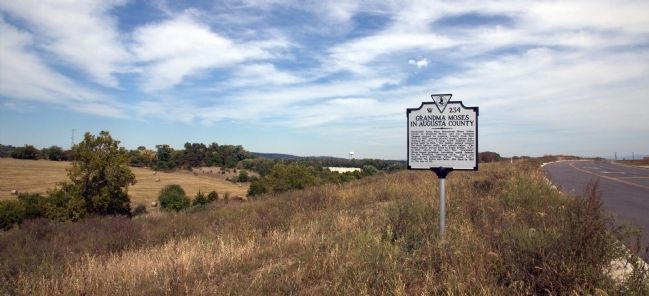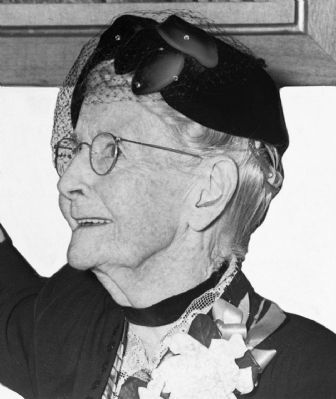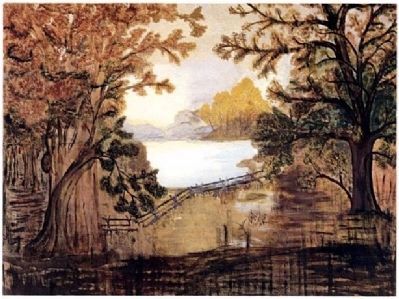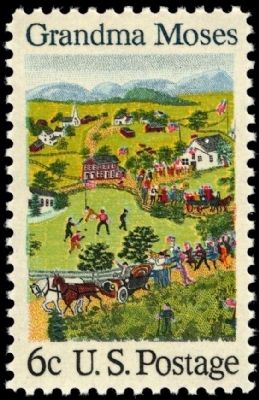Near Verona in Augusta County, Virginia — The American South (Mid-Atlantic)
Grandma Moses in Augusta County
Erected 2014 by Department of Historic Resources. (Marker Number W-234.)
Topics and series. This historical marker is listed in these topic lists: Agriculture • Architecture • Arts, Letters, Music • Industry & Commerce • Women. In addition, it is included in the Virginia Department of Historic Resources (DHR) series list. A significant historical year for this entry is 1887.
Location. 38° 11.154′ N, 79° 0.778′ W. Marker is near Verona, Virginia, in Augusta County. Marker is on Mill Place Parkway (County Route 1943) south of Laurel Hill Road (County Route 612). It is off of Interstate 81 Exit 227. Exit west, then make the first left onto Mill Place Parkway. Touch for map. Marker is in this post office area: Verona VA 24482, United States of America. Touch for directions.
Other nearby markers. At least 8 other markers are within 4 miles of this marker, measured as the crow flies. Birthplace of Woodrow Wilson (approx. 1.4 miles away); The Virginia School for the Deaf and the Blind (approx. 3.7 miles away); United States National Military Cemetery - Staunton (approx. 3.7 miles away); Veterans Memorial (approx. 3.7 miles away); Medal of Honor Memorial (approx. 3.7 miles away); Address by President Lincoln (approx. 3.7 miles away); Staunton National Cemetery (approx. 3.7 miles away); A National Cemetery System (approx. 3.7 miles away).
More about this marker. The marker was cast and shows the year 2011. But is was not erected until 2014, when the parkway was extended to its location.
Also see . . .
1. Virginia Department of Historic Resources website entry. The associated National Register of Historic Places PDF file also contains photographs of Mt. Airy beginning on page 21. Excerpts:
“Located in Augusta County, Virginia, Mt. Airy is a Shenandoah Valley I-house that was constructed ca. 1840 while under the ownership of Major James Crawford. Occupying a 400-acre parcel, it is set on the top of a hill overlooking the Augusta County government center to the north and agricultural land on the east, west, and south. The house is a brick, two-story, five-bay, single-pile house with a central passage. It includes a rear one-and-a-half-story, brick ell addition, constructed ca. 1850, which was common for early-nineteenth-century Shenandoah Valley I-houses. The main block of the house has Federal-style details, including a steeply-pitched roof with an exterior brick corbelled cornice, gable-end chimneys, windows topped by lintels that are flanked by bull’s-eye blocks, interior molded chair railings, and elaborate fireplace mantels. One mantel on the first floor appears to have been replaced with a Greek Revival-style mantel. The rear-ell addition displays Greek Revival-style trim and doors and a Federal-style mantel, which most likely was moved from the main block. Mt. Airy has back and side porches which were added in the late nineteenth century. The side porch encloses the original bulkhead entrance to the half basement. The front porch has been removed , but there are ghost marks of the original one-bay porch and a later three-bay porch. Three contributing frame outbuildings exist on the property.”
Historic Context: Grandma Moses. “Anna Mary Robertson was born on September 7, 1860, to Russell King Robertson and Margaret Shanahan in Washington County, New York. She was one of ten children. She grew up on their family farm with occasional visits to her father’s flax mill. In her childhood she occasionally had the opportunity to express herself artistically. In her autobiography, she speaks of painting leaves, making corncob dolls, and drawing maps at school, where the mountains were admired by her teacher. Her father often encouraged these activities, but her mother thought Anna’s time was better spent rocking the children and on household chores. Anna’s father was partial to art himself. His family built wagons and was one of the first companies to start painting the wagons, including monograms. While Russell Robertson was recovering from an illness , he painted landscapes on the wall of the family home. In one of his known paintings, Robertson demonstrates an understanding of artistic principles and a steady hand.
“At the age of twelve, Anna left home to work as a hired girl to other families. These families often treated her as one

Photographed By J. J. Prats, September 23, 2012
3. Mt. Airy
This view is from the parking lot of the Augusta County Service Authority, currently reachable from U.S. Route 11 and I suspect soon to be reachable from Technology Drive. Technology Drive will connect to Mill Place Parkway and I'm guessing the marker might move a bit closer to Mt. Airy after that occurs. This photo was taken two years before the marker was erected.
“A couple days later, Anna and Thomas Moses decided to stay in Staunton and forgo traveling further south to a nonguaranteed job. They resided on the Bell farm from November 1887 to November 1888. The farm was 100 acres and most of their furniture and livestock came from the previous residents. While at the farm, Anna traded eggs from her hens and accumulated over a hundred chickens of different varieties. In addition to her chickens, Anna started another industry at the Bell farm—turning butter. Anna made butter one day and decided to trade it for groceries. As she puts it, ‘[I] always wanted to be independent, I couldn’t bear the thought of sitting down and Thomas handing out the money.’ Mr. Spitlar at the grocery store offered her twelve cents per pound for any future butter. After the Spitlar family consumed some of the butter, Mr. Spitlar offered fifteen cents per pound because his family liked it so much. Soon thereafter, the Moseses
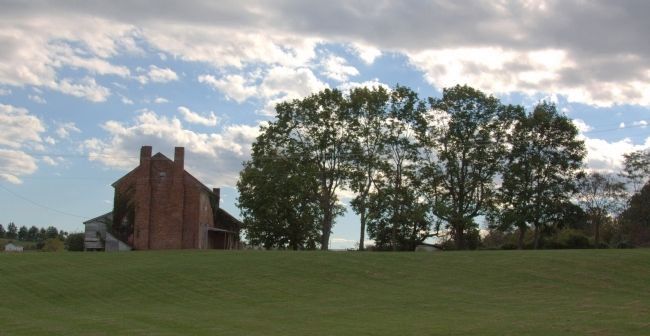
Photographed By J. J. Prats, September 23, 2012
4. Grandma Moses' Mt. Airy in Augusta County, Virginia
The house faces the railroad (out of frame to the right) and beyond the railroad is Lee Highway (U.S. 11) the main north-south road in the Shenandoah Valley. It's driveway is labeled as Cedar Lane on U.S. 11, but is gated at the highway. It is owned by Augusta County.
“Anna and Thomas spent seven years at the Eakle farm, also called Belvidere from 1888 to February 1895. Here Thomas took produce to the local market, while Anna’s butter industry grew. She received over $3,000 annually for her butter At this time, Thomas ordered a barrel churn and a butter press from New York. He carved ‘MOSES’ into the press, meaning every pound of butter had the name Moses on it. While living at Belvidere, Thomas’s sister and her husband, Mattie and Charlie Pebbles, moved down from New York. They would help not only with the normal farming activities, but also with the butter operation and with the children. Anna and Thomas had their first five children while living at Belvidere. Three of these children survived to adulthood, Winona, Loyd, and Forrest. With the birth of her children, Anna started being referred to as Mother Moses and would sign her letters in this manner. In February 1895, Belvidere was sold at auction because of Eakle family financial issues, although in her autobiography Anna cites Mr. Eakle’s death as the reason.
“The Moses family next lived at the Dudley farm, which they rented for $700 a year from February 1895 to June 1901. Anna stopped her butter production when she moved there, but she kept herself busy by washing the many milk jugs Thomas used on his milk route. Anna also bore her daughter Anna while living at the Dudley farm.
“When the Dudley family decided they wanted to move back to their farm, Anna and Thomas decided it was
time to
purchase their own home. With that, they bought Mt. Airy in Verona for $6,000 and lived there from January 1901 to
September 1902. This was the first house that the two bought and did not rent. While living there their last child was born,
Hugh, and the whole family was baptized at the Emmanuel Episcopal Church in Staunton. Thomas by this point was very
homesick and wanted to return to New York and Anna thought Mt. Airy was too far removed from schools. They sold Mt.
Airy to the Hoovers and some adjacent land to Maxie Myers in 1902.
“Before returning north, however, Anna wanted to make proper winter clothes for her children, who were not used to the northern cold. To do this they moved closer into town and schools to a house with 20 acres of land. Mr. Greer, a postal worker staying with them and relative to the Greers next-door, named the house Mt. Nebo after the mountain where Moses from the Bible received his vision of the promised land. While living at Mt. Nebo, the children went to Staunton Academy, Thomas managed a nearby farm, and Anna started a new industry. Anna began making and selling potato chips for twenty-five cents per pound, a food item that was foreign to the Shenandoah Valley. On December 7, 1905, the Moses family sold Mt. Nebo to purchase their farm in New York, which they also called Mt. Nebo. They then moved to Eagle’s Bridge, New York, where they continued to be farmers. Grandma Moses stated in her autobiography that she was homesick for the Valley, stating that she felt as if she were in a swamp in the much lower mountains of New York and that even though ‘some call [eagle bridge’s] a pretty valley, but give me the Shenandoah Valley, every time!’ She stayed in touch with her friends from Virginia, in both the form of writing letters and the occasional visit, and she called her children ‘rebels’ because they were born in the South and held the beliefs of southerners. She maintained her connections to the Shenandoah Valley throughout her life.
Thomas died suddenly in 1927 at the age of 77. When asked about her life, it is the years between her birth and Thomas’s death that Anna would cite as the most important. However, it is the years after his death that made her so well known. At that time, their son Hugh and his wife moved in to take care of the family farm. Anna, without a house to fully care for, started her third and most successful industry— painting.
“Grandma Moses, a name she revived when she had grandchildren, briefly dabbled in the arts before Thomas’s death. She occasionally had the opportunity as a child to color on paper, paint leaves, and make dolls with found materials. In her adult years she would paint the occasional small painting to give as a gift. Her first ‘large picture,’ as she called it, came in 1918 when she ran out of wallpaper to cover the fireboard and painted a landscape of a river and trees on it. In the 1930s, she started making worsted pictures, at the request of her daughter Anna. When Grandma Moses’s hands became too arthritic to create pictures with yarn, her sister Celestia suggested Anna start to paint instead. And Anna did. One statement of hers that is often quoted is that if she hadn’t started painting, she would have raised chickens, meaning painting was something just to keep herself occupied. She did not actively sell or advertise her paintings, but gave them away and occasionally sold them for about five dollars. An act of fate at another drugstore would bring Grandma Moses’s images into the homes of many people and once again change the course of her life.
“On Easter, 1938, Louis Caldor stopped at the Hoosick Valley Falls Drugstore where some of Grandma Moses’s paintings were on display in the window. Caldor was intrigued by the pictures, bought all of them, and went straight over to Grandma Moses’s house to meet her and see if she had any more. Caldor became Moses’s advocate. A while later Caldor came back with a gallery that wanted to display Moses’ work, Otto Kallir’s St. Etienne in New York City. The first exhibit of Grandma Moses, ‘What a Farm Wife Painted,’ was at Kallir’s gallery in the autumn of 1940. A newspaper headline covering the exhibit stated, ‘Mrs. Anna Mary Robertson Moses, known to the countryside around Greenwich, New York, as Grandma Moses ....’, promoting her to the nation as Grandma. Gimbal’s department store Thanksgiving display was the next exhibit and the first time Grandma Moses would go to New York City. As she spoke to the crowd, people became infatuated with her. This was the start of the growth of her artistic career. By the end of it she would paint over 1,000 paintings, become a household name, be associated with advertisements, have her paintings depicted on products like tiles, dishes, and fabric, receive the Women’s National Press Club trophy from President Truman, and become an American phenomenon.
“Grandma Moses’s paintings were mostly of memories from her life. They included images of her childhood and married life. She depicted the years most important to herself. Typically the paintings showed an expansive landscape with multiple figures in the front, often conducting a task she had done or seen on the farm. Art critics often spoke of her work with disdain, but the American people could not seem to get enough. In a time when people feared atomic bombs and depression, Grandma Moses paintings depicted a life Americans wanted to identify with. Americans did not ideally see themselves as factory workers, but as workers of the land. Grandma Moses saw a lot of changes in her life, but painted mostly what she saw before America became an industrial giant. Her work was also in great contrast to the current art of cubism, but still had an air of modernity with her flat figures, which as her work progressed became more abstract. It was not just the paintings that made people want them but also Grandma Moses herself. She was more likely to get in front of a crowd and talk about her jams than to discuss art. If one were to ask her how she painted, she told them in a very systematic way about finding a frame, cutting the board to fit, and applying paint. She was a lady who was of another world. At the age of 101 Grandma Moses passed away, leaving behind her memory and hope through her paintings.
“She left at least thirty-eight paintings depicting scenes in Virginia. The paintings were not catalogued by location, but many titles describe the setting she was painting. Of her titles, eight mention Belvidere, three mention Mt. Airy, and eleven mention Staunton or the Shenandoah Valley. Another prominent theme from Virginia was the ‘Old Mill’ of which she painted at least six paintings. The paintings of Virginia, though few in number, show her link to the Valley and her fondness for it. She spent many years in the Valley gazing out into the landscape and learning the characteristics of nature that she would later depict so accurately in her paintings.
“Grandma Moses was a prominent painter who started creating pictures in the 1930s. Virginia does not hold claim to many nationally known painters. The other known Virginia painters may include: Lucien Powell who, unlike Moses, was a trained artist; Georgia O'Keeffe, a trained abstract painter born in Wisconsin in 1887 and moved to Charlottesville, Virginia, in 1909; and P. Buckley Moss, another folk artist born in 1933 who moved to the city of Waynesboro from New York in 1964. O'Keeffe and Moss are the next most noted painters who lived in Virginia, after Moses. The story of P. Buckley Moss is most like Moses, having been born in New York and moving to the Shenandoah Valley. However, Moss was a trained artist. She did not have the folk artist title, like Moses, and instead of depicting scenes full of farm life, Moss depicted a lot of scenes of buildings and carriage rides, with little depiction of people, expansive scenery, or the daily chores of a farm.
“Yet Grandma Moses is perhaps the most famous. By the end of her life, she would be a household name with her birthdays documented in many magazines and her paintings on a large variety of products, including plates, fabric, and advertisements. Even today, fifty years after Grandma Moses' death, products with her images are still sold and she and her paintings are taught to millions of school children nationwide.” (Submitted on September 27, 2014.)
2. Grandma Moses. Wikipedia entry:
“The New York Times said of her: ‘The simple realism, nostalgic atmosphere and luminous color with which Grandma Moses portrayed homely farm life and rural countryside won her a wide following. She was able to capture the excitement of winter's first snow, Thanksgiving preparations and the new, young green of oncoming spring... In person, Grandma Moses charmed wherever she went. A tiny, lively woman with mischievous gray eyes and a quick wit, she could be sharp-tongued with a sycophant and stern with an errant grandchild’.” (Submitted on September 27, 2014.)
Credits. This page was last revised on May 1, 2022. It was originally submitted on September 27, 2014, by J. J. Prats of Powell, Ohio. This page has been viewed 2,886 times since then and 878 times this year. Photos: 1, 2, 3, 4, 5, 6, 7. submitted on September 27, 2014, by J. J. Prats of Powell, Ohio.

